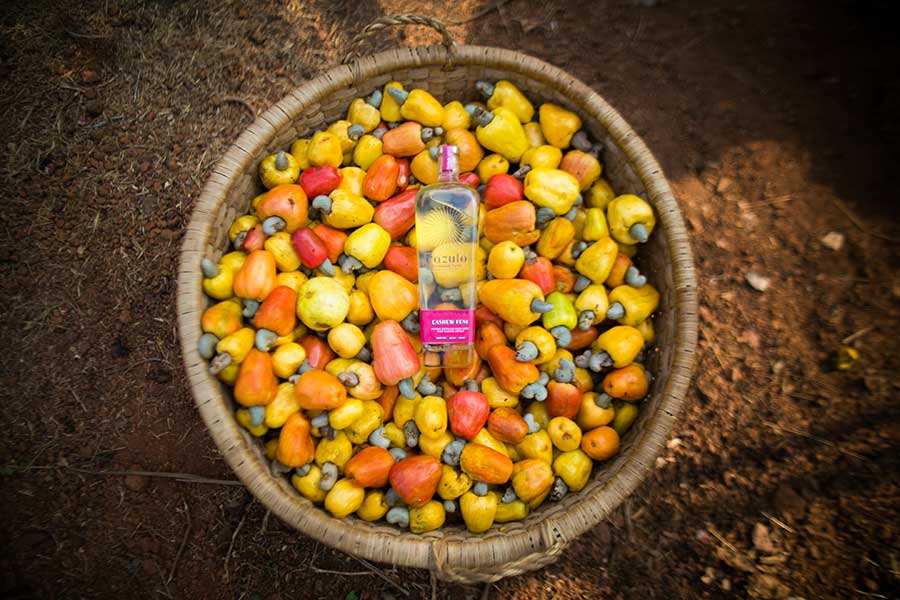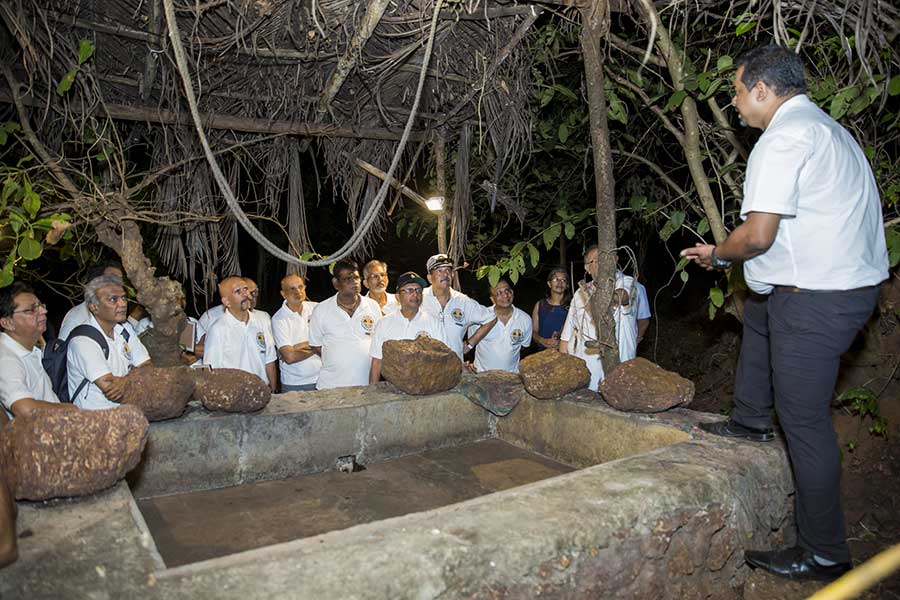Feni is the only spirit to have a Geographical Indication (GI) status in India. Even though this popular indigenous liquor from Goa has been fighting a long battle for acceptance in the domestic and global market, with a few visionary Feni producers at the helm of a new movement, things are finally looking up. Rojita Tiwari finds out more.

For the longest time, Indian drink enthusiasts have been asking this question, what is India’s original spirit? Alcohol has a checkered past in India, and even though it is one of the largest drinks markets in the world, liquor remains a taboo in many parts of the country. But, no one can deny its presence in Indian society in various forms for centuries now. Local drinks such as Feni and others termed country liquor still hold a majority market share in India.
The Beginning
Feni (from cashew apple), Mahua (from wild Mahua flower), Chaang (barley or rice beer), Toddy (sap of the palm tree), and many more types of local fermented, brewed, and distilled liquor is consumed in the households of various states of India. Interestingly, the Portuguese brought the first cashew tree to Goa nearly 500 years ago. The earliest mention of Feni is in a 1584 journal of a Dutch merchant called Jan Huyghen van Linschoten who was a trader and a spy who lived in Goa during that time. His journal mentions coconut feni that probably existed even before cashew feni came into existence. The word Feni comes from the Sanskrit word ‘phena’.
Feni & the Goan Culture
According to the locals, in ancient times, Feni made from ginger, cumin, etc. was used for treating various health ailments such as stomach aches, body aches, joint pain, etc. However, currently only Feni made from cashew or coconut are widely available.
Urrack, the first distillate of the cashew apple juice (25% to 30% abv) is an equally revered seasonal drink of the Goans, who enjoy the refreshing drink between mid-March to the end of April.
It is almost impossible to think of Goa without this famous drink. From being an intrinsic part of the local festivals, music, art, murals, or a mundane laid-back beach life to the high-energy bars and restaurants, Feni has come a long way. The credit for that goes to a few Goans working relentlessly to offer Feni a well-deserved heritage spirit status.

Feni Going Global
Fazenda Cazulo is a manufacturer of one of Goa’s oldest and finest Feni. The Cazulo brand is also the best know brand across India as well as in international markets. Established in 1982 by Wildon and Melanie Vaz at Cuncolim, South Goa, this family-run business today sells coconut and cashew Feni made from the best locally sourced ingredients. Hansel Vaz, the current generation of the Vaz family has been instrumental in bringing the limelight to the local spirit. He not only organises bespoke fine-tasting tours at his distillery but also helps formulate laws pertaining to this category.
Vaz says, “As the Hon. Secretary of the All Goa Cashew Feni Distillers and Bottlers Association, we have continually liaised between the ‘Bhaticar’ (distillers) and the government to foster a proactive policy for Feni released last year. We also ensured that Feni is categorised at least in Goa as a Heritage Spirit. I have drafted the GI for Coconut Feni. Cashew Feni, acquired the GI status in 2009. Feni got listed as a separate category in Food Safety & Standards Authority of India (FSSAI) and the Food & Drug Administration (FDA). We have also opened up a new tourism niche, Feni Tourism.”
Another Feni producer Solomon Diniz is the fourth-generation distiller from Goa whose family owns Adinco Distillery. They produce a heritage-style feni called Tinto. Adinco began operations in the late 1800s when Aleixo Diniz first started distilling Feni at his home in Quepem, Goa. The company was established in the year 1970, and the production unit was set up in the year 2000 only.
Diniz says, “We have been producing Feni in its heritage style of distilling, educating consumers through social media, organizing events, bar takeovers, and training sessions for the hospitality industry. Most importantly, we are making it available in the other states and Union Territories, such as Maharashtra, Pondicherry, and Kolkata.”
Types and Flavours of Feni & How to enjoy it
According to Vaz’s research, there are at least 26 expressions of Feni. Available in three styles Feni- pure cashew or coconut toddy distillate, Botanical Feni or Dukshiri- similar to gin and Conserva Feni – liqueur style. He invites curious consumers to visit Fazenda Cazulo in Goa for a first-hand experience of tasting and learning about this complex spirit.
Diniz describes, “The flavour of a well-made feni has the true spirit of Goa packed with complex notes of tropical and citrus fruits along with the hint of pepper. The spirit is double distilled in a pot still using a traditional method. I advise beginners to pair it with tropical season fruits, green chili, fresh lime soda, or sour fruit. Feni also goes well with authentic Goan cuisine.”

Pankaj Balachandran, a renowned mixologist and partner of Bar Tesouro, a modern bar in Goa that boasts an impressive feni cocktail menu speak of the versatility of Feni as a base for cocktails. “I was only introduced to Feni a few years back, and what impressed me is the depth and character of the spirit that always transcends into the cocktail you make, something like in case of pisco, tequila, or mezcal.
Feni is on the same page when it comes to versatility. At Tesouro, we are easing people into trying feni cocktails. Yes, it requires a bit of getting used to for sure. But when consumers see the spirit in cocktails like a negroni, a spritzer, etc., they do not mind giving it a try. Once they try the spirit, and enjoy the character and style, they comeback for more. Slowly you peel the layers, and introduce them to the spirit in all its might and honour. You would be surprised to see how many people come back for more.”
His favourite Feni cocktail, Terra Bebida is made with Dukshiri Feni 20 ml, Campari 20 ml, Rosso 20 ml, and cold brew 10 ml served in an Old Fashioned glass and garnished with an orange twist.
The future of Feni
Vaz feels that the future of Feni depends on the excise policies of states in India. “At present overseas exports seem lucrative and bureaucratically simpler than the domestic market. Fortunately, Goa is the preferred holiday destination for Indian travellers. A bulk of our sales come from tourists.” Diniz feels that the future is very bright, as people start to accept the flavours of feni, and there is a gradual increase in good branded Feni available across stores and HORECA.
It is clear that the government of India has to back Feni, just like the French back champagne or the Japanese promote Sake, says Vaz. “I would be delighted to hear from any Indian embassy for a request for feni to be served at official engagements.”
Relying more on active marketing and promotion strategies is going to give a boost to the Feni culture in India, believes Diniz. “We can do bar-training, curate cocktail program, put out word through mixologists, influencers, and we are going to start a distillery tour experience in which we will conduct tasting sessions in tradition old working distillery.”
For the longest time Feni has been fighting the battle of acceptance with a breed of drinkers who found the spirit too strong in aroma profile and sometimes undrinkable. But thanks to these new-age feni producers, the spirit is finally gaining the desired respect as a heritage spirit. Vaz feels that it would be preposterous to attempt to change the image of a drink that is 450 year-old like Feni. Like Mezcal, the story of Feni deserves to be shared.
Diniz somewhat agrees with Vaz that educating consumers and small distillery owners on rules of distillation process and following a standard operational practice could go a long way in benefiting the image of the spirit.
Feni enthusiasts believe that the goan artisanal drink is on its way to becoming a global spirit. As Vaz rightly sums it up, “Feni is the original ‘Make-in-India’ story and can be truly celebrated in a way like no other!”

– Rojita Tiwari is the Founder of Drinks & Destinations, a wine & spirits consulting firm in India. She is an award-winning drinks writer, educator, trainer & consultant, and a juror at several international wine, spirits & cocktail competitions. She is a Senior Specialist at International Drinks Specialist, the UK, and co-founder of Agents Of Cheer & Story In A Bottle, India’s foremost curated drinks events. Her Instagram handle is @rojitatiwari.
Steps in the production of Feni
First, ripe cashew apples are harvested by hand and placed in baskets for three months in the spring. The outer nut is then separated from the fruit by hand and the fruit is pressed in one or two steps, either mechanically or with the feet, like the crushing of grapes in some traditional wines. The result is a nectar that is more or less rich in pulp and a clearer juice called niro. Some producers use only the first press, a bit like for fruit brandies, others clarify the whole. Fermentation then takes between three and five days. After the first distillation over a wood fire, we obtain a brouillis called urak titrating about 15% vol. It is only after the second distillation that feni is obtained, around 40% vol. but some producers may employ a triple distillation, sometimes by suspending a bag of aromatics in the atmosphere of the still to make masala feni. It is almost related to gin or mezcal pechuga.
4,000 micro-distilleries
There are about 4,000 micro-distilleries, but this figure can vary as not all distilleries apply for authorization from the local authorities every season. Indeed, if some distilleries have metal or copper stills for all or part, with concrete tanks, most of them use traditional clay stills called bhattis. They consist of a part that will be heated, the budkula, then a bamboo tube or nolo will connect it to another clay container called launi on which water will be poured to condense the alcohol vapours. Fabrics and rope are applied to ensure the tightness of the alembic, then mud or even ash is applied in addition to ensure a good distribution of the heat. This type of still is ephemeral and can easily be rebuilt and thus moved. Traces of this type of alembic have been found dating back more than two millenniums!
Alexandre Vingtier for Spirit Hunters
